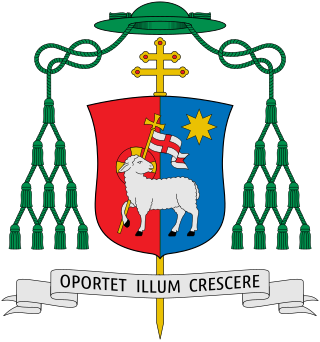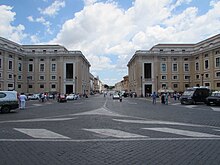The Roman Curia comprises the administrative institutions of the Holy See and the central body through which the affairs of the Roman Catholic Church are conducted. The Roman Curia is the institution which the Roman Pontiff ordinarily makes use of in the exercise of his supreme pastoral office and universal mission in the world: thus curialism refers traditionally to an emphasis on the supreme authority of the Holy See within the Catholic Church. It is at the service of the Pope, successor of Apostle Peter and of the Bishops, successors of the Apostles, according to the modalities that are proper to the nature of each one, fulfilling their function with an evangelical spirit, working for the good and at the service of communion, unity and edification of the Universal Church and attending to the demands of the world in which the Church is called to fulfill its duty and mission.
A Pontifical University or Athenaeum is an ecclesiastical university established or approved directly by the Holy See, composed of three main ecclesiastical faculties and at least one other faculty. These academic institutes deal specifically with Christian revelation and related disciplines, and the Church's mission of spreading the Gospel, as proclaimed in the apostolic constitution Sapientiachristiana. As of 2018, they are governed by the apostolic constitution Veritatis gaudium issued by Pope Francis on 8 December 2017.

Zenon Grocholewski was a Polish prelate of the Catholic Church, who was elevated to the rank of cardinal in 2001. He joined the Roman Curia in 1972 and served from 1999 until 2015 as Prefect of the Congregation for Catholic Education and Grand Chancellor of the Pontifical Gregorian University.

The Dicastery for the Clergy, formerly named Congregation for the Clergy, is the dicastery of the Roman Curia responsible for overseeing matters regarding priests and deacons not belonging to religious orders. The Congregation for the Clergy handles requests for dispensation from active priestly ministry, as well as the legislation governing presbyteral councils and other organisations of priests around the world. The Congregation does not deal with clerical sexual abuse cases, as those are handled exclusively by the Dicastery for the Doctrine of the Faith.
The Secretariat of State is the oldest dicastery in the Roman Curia, the central papal governing bureaucracy of the Catholic Church. It is headed by the Cardinal Secretary of State and performs all the political and diplomatic functions of the Holy See. The Secretariat is divided into three sections: the Section for General Affairs, the Section for Relations with States, and, since 2017, the Section for Diplomatic Staff.

The Dicastery for Divine Worship and the Discipline of the Sacraments is the dicastery of the Roman Curia that handles most affairs relating to liturgical practices of the Latin Church as distinct from the Eastern Catholic Churches and also some technical matters relating to the sacraments.

The Dicastery for the Eastern Churches, previously named Congregation for the Oriental Churches or Congregation for the Eastern Churches, is a dicastery of the Roman Curia responsible for contact with the Eastern Catholic churches for the sake of assisting their development and protecting their rights. It also maintains whole and entire in the one Catholic Church the heritage and canon law of the various Eastern Catholic traditions. It has exclusive authority over the following regions: Egypt and the Sinai Peninsula, Eritrea and northern Ethiopia, southern Albania and Bulgaria, Cyprus, Greece, Iran, Iraq, Lebanon, Israel, Syria, Jordan and Turkey, and also oversees jurisdictions based in Romania, Southern Italy, Hungary, India and Ukraine.
In the Roman Curia of the Catholic Church, a congregation was a type of department. They were second-highest-ranking departments, ranking below the two Secretariats, and above the pontifical councils, pontifical commissions, tribunals and offices.
The Doctor of Sacred Theology, also sometimes known as Professor of Sacred Theology, is the final theological degree in the pontifical university system of the Catholic Church, being the ecclesiastical equivalent of the academic Doctor of Theology (ThD) degree.
The Baccalaureate in Sacred Theology, not to be confused with a Bachelor of Arts in Theology, is the first of three ecclesiastical degrees in theology which are conferred by a number of pontifical faculties around the world.

Virgilio Noè was an Italian Roman Catholic prelate and cardinal. He was elevated to the cardinalate in 1991.
Licentiate of Canon Law is the title of an advanced graduate degree with canonical effects in the Roman Catholic Church offered by pontifical universities and ecclesiastical faculties of canon law. Licentiate is the title of a person who holds an academic degree called a licence. The licentiate of canon law is the ordinary way for forming future canonists, according to Veritatis gaudium.
Pastor bonus is an apostolic constitution promulgated by Pope John Paul II on 28 June 1988. It instituted a number of reforms in the process of running the central government of the Catholic Church.
A pontifical university or athenaeum is a Catholic university established by and directly under the authority of the Holy See. It is licensed to grant academic degrees in sacred faculties, the most important of which are theology, canon law, and philosophy. Pontifical universities follow a European system of degrees in the sacred faculties, granting the baccalaureate, the licentiate, and the doctorate.

Giovanni Pietro Dal Toso PhD JCL is an Italian Roman Catholic prelate who works in the diplomatic service of the Holy See.
The Pontifical Faculty of Theology of Sardinia is a theological academic institution founded by pope Pius XI in Cuglieri with the Apostolic Constitution Nostrarum Partem of 5 August 1927. It was the first Italian Faculty of Theology extra urbem.

Angelo Vincenzo Zani is an Italian prelate of the Catholic Church, who was named Archivist and Librarian of the Holy Roman Church in September 2022. He was the Secretary of the Congregation for Catholic Education, its second-highest officer, from November 2012 to September 2022 after serving as its third-highest official for ten years. He has been an archbishop since 2013.

The San Damaso Ecclesiastical University is a catholic university erected by the Holy See in the Archdiocese of Madrid (Spain). It teaches Philosophy, Theology, Classical Philology, Canon Law and Religion Sciences with official validity in all the universities of the Catholic Church. Its name is taken from the Pope Damasus I.
Veritatis gaudium is an apostolic constitution on ecclesiastical universities and faculties. It was signed by Pope Francis on 8 December 2017 and entered into force on 29 January 2018. It updates the 1979 apostolic constitution Sapientia christiana. The document is 87 pages in length. The new norms took legal effect on the first day of the 2018-2019 academic year or of the 2019 academic year, depending on the school year of particular institutions.
The Dicastery for Culture and Education is an administrative unit of the Roman Curia. It began operations on 5 June 2022 as established by the apostolic constitution Praedicate evangelium promulgated on 19 March 2022. It was formed through the merger of two earlier bodies, the Pontifical Council for Culture and the Congregation for Catholic Education.










